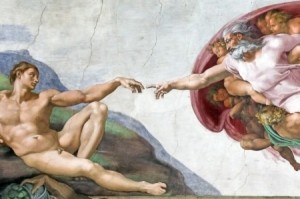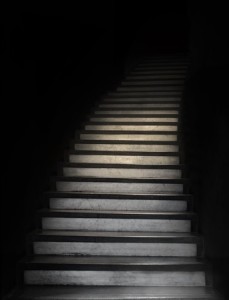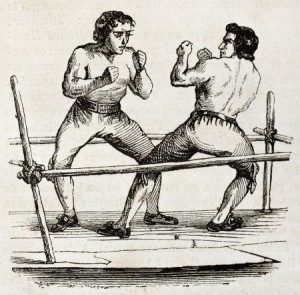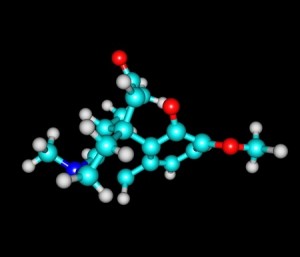Surprised by My Utmost
Joe was an enthusiastic kind of guy. When he found something he liked, he wanted his friends to like it or try it. He’s the guy who convinced me to try rock climbing (Don’t Ever Give Up). So when he started talking about how great a devotional My Utmost for His Highest was, I took his endorsement with a grain of salt … at first. When other people who tried it started saying how much they liked it, I tried it. Oswald Chambers has been a regular part of my devotional life since then.
I still have my original copy. The binding split years ago, so I taped it with blue electric tape. It is full of notes, underlined and starred passages and a few coffee-stains. Inside is a crisp $2 bill from the Bank of Jamaica—a souvenir from a short-term missions trip to Jamaica—that I used for a bookmark. These days I’ve gone digital, with “OC” coming up daily when I open my Logos Bible software program as I drink my morning coffee. I’ve been posting selections from three different devotionals on my facebook page for a number of years now, but My Utmost always seems to be the one most quoted.
There is a short comment in my hardbound copy for the January 18th devotion, “began.” On that day I made a note summarizing what stood out to me, “be devoted to the Lord, not to service.” I had underlined the following paragraph:
Beware of anything that competes with loyalty to Jesus Christ. The greatest competitor of devotion to Jesus is service for Him. It is easier to serve than to be drunk to the dregs. The one aim of the call of God is the satisfaction of God, not a call to do something for Him. We are not sent to battle for God, but to be used by God in His battlings. Are we being more devoted to service than to Jesus Christ?
I can’t say I have always been more devoted to Christ than to service, but at least once each year Oswald asks me if I am. Actually, he does this repeatedly throughout the year. March 29th is one of those times. My page note said: “Be ready for the coming of our Lord more than to do service.” Within the devotional for that day, Chambers had said: “It is not service that matters, but intense spiritual reality, expecting Jesus Christ at every turn.”
August 30th didn’t have a page note, but I had starred and underlined this passage:
When once you are rightly related to God by salvation and sanctification, remember that wherever you are, you are put there by God; and by the reaction of your life on the circumstances around you, you will fulfill God’s purpose, as long as you keep in the light as God is in the light.
There’s more, but I’ll stop with the quotes here. Get a personal copy and see if what Joe told me so many years ago is true for you: “It’s as if day after day, Chambers is hitting me right between the eyes with something I needed to hear.”
Oswald Chambers was born in Aberdeen Scotland on July 24th, 1874 and he died on November 15th, 1917 at the age of 43. While at the University of Edinburgh, he felt called to the ministry and went to Dunoon College, a small theological training school near Glasgow. He traveled for a couple of years in 1906 and 1907, teaching for a semester in Cincinnati and working in Japan with Charles Cowan, a co-founder of the Oriental Missionary Society. While in America he met Gertrude Hobbs, who he married in May of 1910. “Biddy,” as Chambers called his wife, could take shorthand at 250 words per minute. It was this skill that eventually contributed to her transcribing and typing his sermons and lessons into written form after his death.
In 1911, Chambers founded the Bible Training College in London, where he taught until 1915, one year after the outbreak of World War I. He suspended the operation of the school and went to Zeitoun Egypt, where he was a YMCA chaplain to Australian and New Zealand troops. But the relatively short time at his school had a big impact. “Between 1911 and 1915, 106 resident students attended the Bible Training College, and by July 1915, forty were serving as missionaries.”
In Egypt, he decided to stop the usual concerts and movies provided by the YMCA for the troops as a social alternative to the brothels of Cairo. He gave Bible classes instead. Skeptics predicted an “exodus” of soldiers from the facilities, but his wooden-framed “hut” became packed with soldiers listening to messages like “What is the Good of Prayer?” When confronted by a soldier who said he couldn’t stand religious people, Chambers replied, “Neither can I.”
He was stricken with appendicitis on October 17th, 1917, but resisted going to a hospital. He was reluctant to take a bed that was needed for the troops being massed for a long-expected battle. His delayed treatment led to needing an emergency appendectomy on October 29th. He died on November 15th from a hemorrhage in his lungs. He was buried in Cairo with full military honors.
For the remainder of her life, Biddy Chambers transcribed and published books and articles from the notes she took during their time at the Bible College and while with the YMCA in Zeitoun. My Utmost for His Highest was first published in 1927. In the foreword, she wrote:
It is because it is felt that the author is one to whose teaching men will return, that this book has been prepared, and it is sent out with the prayer that day by day the messages may continue to bring the quickening life and inspiration of the Holy Spirit.
For me, and many others her prayer was answered.
Parallel to the discipling I received from Oswald Chambers over the years has been my counseling with people struggling with drug and alcohol problems. To my surprise, when I began doing research for my dissertation on the spiritual and religious distinction in Alcoholics Anonymous and the Twelve Steps, I discovered that early A.A. used My Utmost for His Highest. According to Dick B., a Christian and A.A. historian, My Utmost was used by early A.A. members—a custom they borrowed from the Oxford Group. Actually, I guess I shouldn’t have been that surprised. This also was an answer to Biddy’s prayer.











